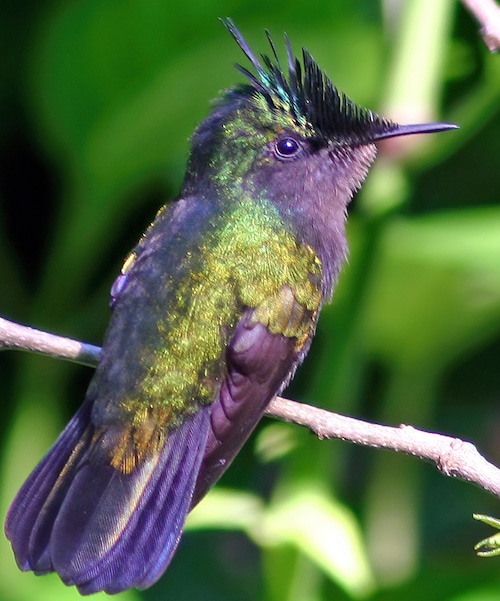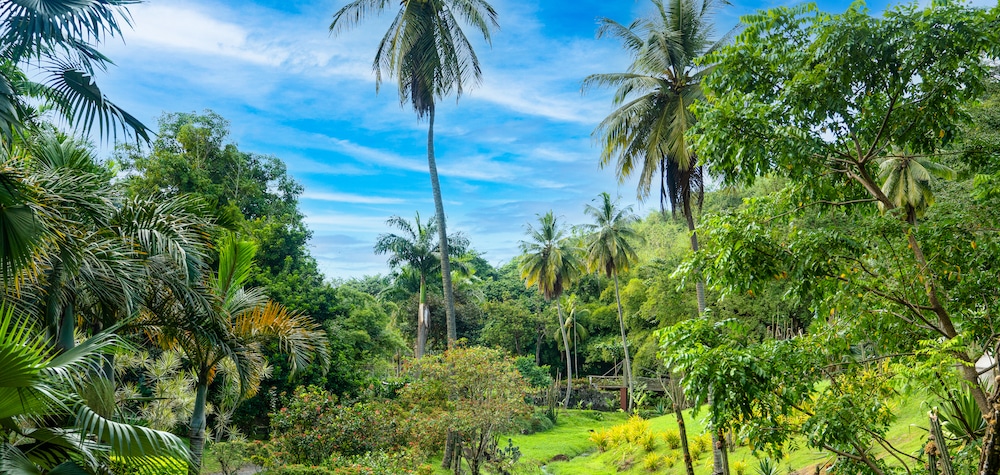Martinique

Martinique is an island in the eastern Caribbean Sea, one of the ‘Windward Islands’ or Lesser Antilles. It lies north of Trinidad and Tobago, having a land area of c. 1,100 km². It is roughly 70k long and 30k wide, at its widest point. The highest point is the volcano Mount Pelée (1.397m). It is an overseas department of France. To the northwest lies Dominica, to the south St Lucia and to the southeast Barbados. As with the other overseas departments, Martinique is also one of the twenty-six regions of France (being an overseas region) and an integral part of the Republic. As part of France, Martinique is part of the European Union, and its currency is the euro. Its official language is French, although almost all of its inhabitants also speak Antillean Creole (Créole Martiniquais).
The Climate is tropical, moderated by trade winds. The rainy season is roughly June to October and the island is vulnerable to devastating cyclones (hurricanes) every eight years on average. Average temperature is c.18 C° and it is generally humid.
The north of the island is mountainous and lushly forested. It features dramatic pitons (conical mountains) and mornes (smaller mountains). The Piton Conil is in the extreme North and dominates the Dominica Channel. Mount Pelee is an active volcano. There is also Morne Jacob, and the Pitons du Carbet, an ensemble of five beautifully shaped, rainforest covered, extinct volcanoes dominating the Bay of Fort de France. The most dominating of the island’s many beautiful mountains, is the infamous volcano Mount Pelée. The volcanic ash has created beautiful grey and black sand beaches in the north (in particular between Anse Ceron and Anse des Gallets), contrasting markedly from the white sands of Les Salines in the south. Due to the island’s geographic and morphological characteristics, it has short and torrential rivers. The Lézarde, 30 km long, is the longest on the island.
The south is more easily traversed, though it still features some impressive geographic features. Because it is easier to travel and because of the many beautiful beaches and food throughout this region, the south receives the bulk of the tourist traffic. The beaches from Pointe de Bout, through Diamant (which features right off the coast the beautiful Roche de Diamant), St. Luce, the town of St. Anne all the way down to Les Salines are very popular.

Jardin Zoologique de Martinique ©IngridDb Creative Commons
Agriculture was the most important sector producing pineapples, bananas and rum from sugar cane. However, a banana pesticide, now banned, has contaminated large areas and impacted on people’s health and fish stocks. France, supports to deficit.
Birding Martinique
The northern end of the island catches most of the rainfall and is heavily forested, featuring species such as bamboo, mahogany, rosewood and West Indian locust. The south is drier and dominated by savanna-like brush, including cacti, Copaiba balsam, logwood and acacia.
Anole lizards and fer-de-lance snakes are native to the island. Small Indian Mongooses Urva auropunctata, were introduced in the 1800s to control the snake population. They have become a destructive intruder as they prey upon bird eggs and have exterminated or endangered a number of native birds, including the Martinique trembler, white-breasted trembler and White-breasted Thrasher.
There are more than 200 species including some Lesser Antilles endemics and one local endemic the Martinique Oriole which population has been severely impacted by introduced Shiny Cowbirds that parasites 75% of oriole nests. Nest are also heavily predated by Carib Grackles.
-
Wikipedia
GNU Free Documentation License
http://en.wikipedia.org/wiki/Martinique
-
Number of bird species: 240
(As at April 2024)
Number of endemics: 1
Martinique Oriole Icterus bonana
-
Avibase
PDF ChecklistThis checklist includes all bird species found in Martinique , based on the best information available at this time. It is based on a wide variety of sources that I collated over many years. I am pleased to offer these checklists as a service to birdwatchers. -
Wikipedia
Annotated ListList of birds of Martinique
-
Birds of the Lesser Antilles - A Photographic Guide
| By Ryan Chenery | Helm | 2022 | Paperback | 224 pages, 400 colour photos | ISBN: 9781472989611 Buy this book from NHBS.com -
The Birds of the West Indies
| By G Michael Flieg & Allan Sander | Bloomsbury Publishing | 2017 | Paperback | 144 pages, colour photos, 1 colour map | Out of Print | ISBN: 9781472938145 Buy this book from NHBS.com -
The Birds of the West Indies
| By Guy M Kirwan, Anthony Levesque, Mark W Oberle & Christopher J Sharpe | Lynx Edicions | 2019 | Flexibound | 400 pages, 1600+ colour illustrations, 650+ colour distribution maps | ISBN: 9788416728176 Buy this book from NHBS.com
-
NR La Caravelle
InformationSatellite ViewNature Reserve of La Caravelle lies toward the center of the island of Martinique, 5.6 miles north-northeast of Le Robert; it's six miles (nine and a half kilometers) to the east-southeast of Sainte Marie. It is comprised of grassy savannas, dry forests, cliffs, beaches, forests, and mangrove thickets, offering a great representation of the different habitats throughout Martinique. -
RNP Martinique Regional Nature Park
InformationSatellite ViewMartinique Regional Nature Park was the first reserve of its kind to be created on a tropical island. Covering 63,000 hectares, it occupies a large part of the island, encompassing 32 of the 34 municipalities of Martinique. La Trinité, Sainte-Anne, Sainte-Marie, Saint-Pierre, Le Diamant, Le Vauclin and Le Morne-Vert are part of this protected territory.
-
2017 [06 June] - Mark Van Beirs
PDF ReportAntigua, Barbuda, Montserrat, Dominica, Guadeloupe, Martinique, Santa Lucia, Saint Vincent, Barbados and Grenada were the ten islands we visited on our recent Lesser Antilles tour. Some are independent countries in their own right, while others are Overseas Territories. All these islands exude a quite different flavour, as some are rich and well developed and some are obviously quite poor with pothole-riddled roads and limited infrastructure. -
2022 [01 January] - St Lucia and Martinique
PDF Report...Up and out in the dark for a pre-dawn crack at the Nightjars was as successful as the evenings had been; big fat zero. More White-breasted Thrashers were nice though. I birded back to the hotel where I met up with VW and we headed out and south to check some ebird Pewee spots... -
2023 [03 March] - Forrest Rowland - Lesser Antilles
PDF ReportMartinique is a fairly extensively developed island, with lots of infrastructure and European tourism. But it still has some very nice habitat left in a few spots. We visited two of these special remnants, one a fine example of dry forest where we enjoyed good views of the local subspecies of Whitebreasted Thrasher, which must be seen. This tour was very much dedicated to attempting all the pertinent subspecies of endemics, near endemics, and other widespread species ripe for splitting. House Wren was the most comical of these examples...
-
French Caribbean International
AccommodationYour Leading Resource for Select Accommodations in the French West Indies.
-
BirdLife Date
Information & Photos -
Martinique Oriole Icterus bonana
InformationThis species qualifies as Vulnerable as it has a very small range and is declining in response to brood-parasitism. Monitoring and assessment of the precise impact of this threat may ultimately result in a revised evaluation of the species's conservation status -
The Birds of Martinique
Information & PhotosMore than 200 bird species frequent Martinique, some of which are endemic to the island or the Lesser Antilles. Here are some of the emblematic specimens that can be seen…

